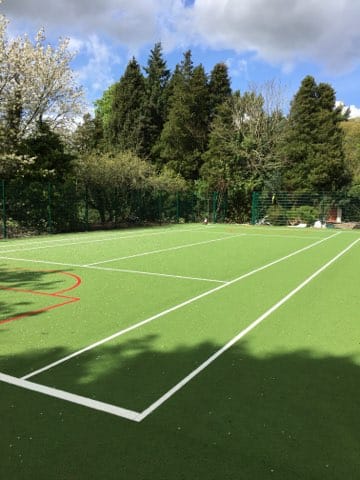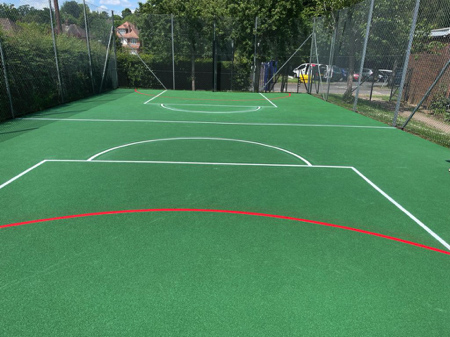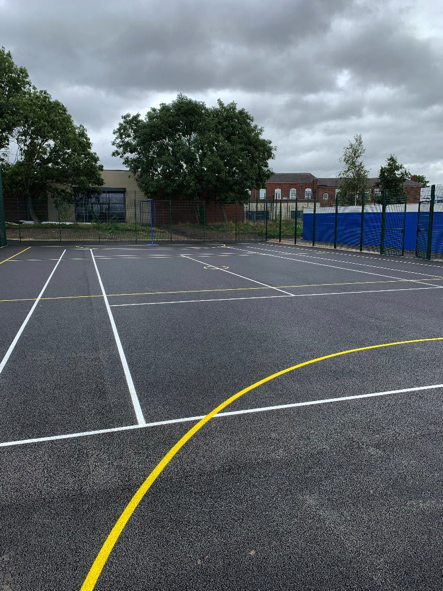- About
- Services
- Play
- Sport
- Case Studies
- News
- Contact
- Pitchbuilder
MUGAs have become central to schools, community centres, and recreational facilities, offering flexible spaces that can accommodate a wide range of sports and activities. However, as the demands on these spaces grow, so too does the need for surfaces that are not only durable and safe but also environmentally sustainable and adaptable to future needs.
Advances in technology have led to the creation of new materials and surface designs that promise to meet these growing demands. Whether it's synthetic turf that mimics the feel of natural grass or innovative polymeric surfaces designed for top-tier performance, the future of MUGA surfaces lies in balancing innovation with practicality.
Choosing the right MUGA surface involves understanding the trade-offs between cost, performance, and sustainability. Here’s a closer look at the primary options:
When it comes to creating an inviting, versatile, and high-performing Multi-Use Games Area (MUGA), synthetic turf stands out as the best option. It offers a consistent playing experience across a wide range of sports—from football to rugby to hockey—making it the go-to surface for schools, communities, and sports facilities.

Polymeric surfaces are known for their superior slip resistance and durability, making them ideal for specialised, high-performance sports settings like international running tracks. However, for larger MUGA areas, particularly in school or community environments, polymeric surfaces may not be the best choice.

Macadam surfaces offer affordability and durability, making them a viable choice for facilities with tighter budgets. However, when compared to synthetic turf, macadam falls short in terms of comfort, aesthetics, and user experience—especially for children and casual sports.

As awareness of environmental issues grows, sustainability has become a key factor in choosing MUGA surfaces. Forward-thinking facility managers are exploring eco-friendly materials, such as recycled synthetic turf or natural alternatives, to reduce the environmental impact of their sports areas. Additionally, the use of permeable surfaces that allow water drainage can help mitigate issues related to runoff and flooding, making your facility more resilient to climate change.
Whilst the industry is looking into alternative infill for 3G multi use surfaces such as cork, mixed organic materials and olive stone to name a few. It is acknowledged by Sport England "the difficulty in trying to balance the health and well-being benefits that come from the use of 3G pitches with environmental sustainability factors".
However, it is also important to note that there are currently no widely available alternative infill products with proven durability on the market that are as effective, suitable for all UK weather conditions and deliver the required performance standards
As you evaluate MUGA surface options, consider not just the immediate needs of your facility but also how those needs might evolve. Here are some factors to keep in mind:
Adaptability: Can the surface accommodate a wide range of sports and activities? Versatility is crucial in ensuring your MUGA remains useful as sports trends change.
Sustainability: How eco-friendly are the materials? Prioritise surfaces that minimise environmental impact.
Cost vs. Value: While staying within budget is important, consider the long-term value of the surface, including maintenance costs and lifespan.
User Experience: How does the surface impact the safety and enjoyment of its users? Surfaces that offer better traction and cushioning can reduce injuries and enhance performance.
Technological Integration: Look for surfaces that can be easily updated or integrated with new technologies, such as smart sensors for monitoring wear and tear
Over the years, we have partnered with schools and sports facilities to design and install state-of-the-art MUGA surfaces that meet the unique needs of each site. From eco-friendly synthetic turf in urban schools to high-performance polymeric surfaces for competitive sports, our case studies showcase how innovative surface solutions can transform recreational spaces.
For expert advice on selecting the ideal MUGA surface for your facility, or to explore how we can help you create a high-quality, sustainable sports area, connect with our knowledgeable team today.
Contact Us:
Our experienced professionals are here to guide you through every step of the process, from initial consultations to after-sales support. Whether you need a detailed quote, have specific questions about our MUGA surfaces, or require expert advice on maintenance and repairs, we’re committed to providing solutions that meet your unique needs. We pride ourselves on delivering exceptional service, ensuring that your sports facility is not only functional and durable but also an asset to your community for years to come.